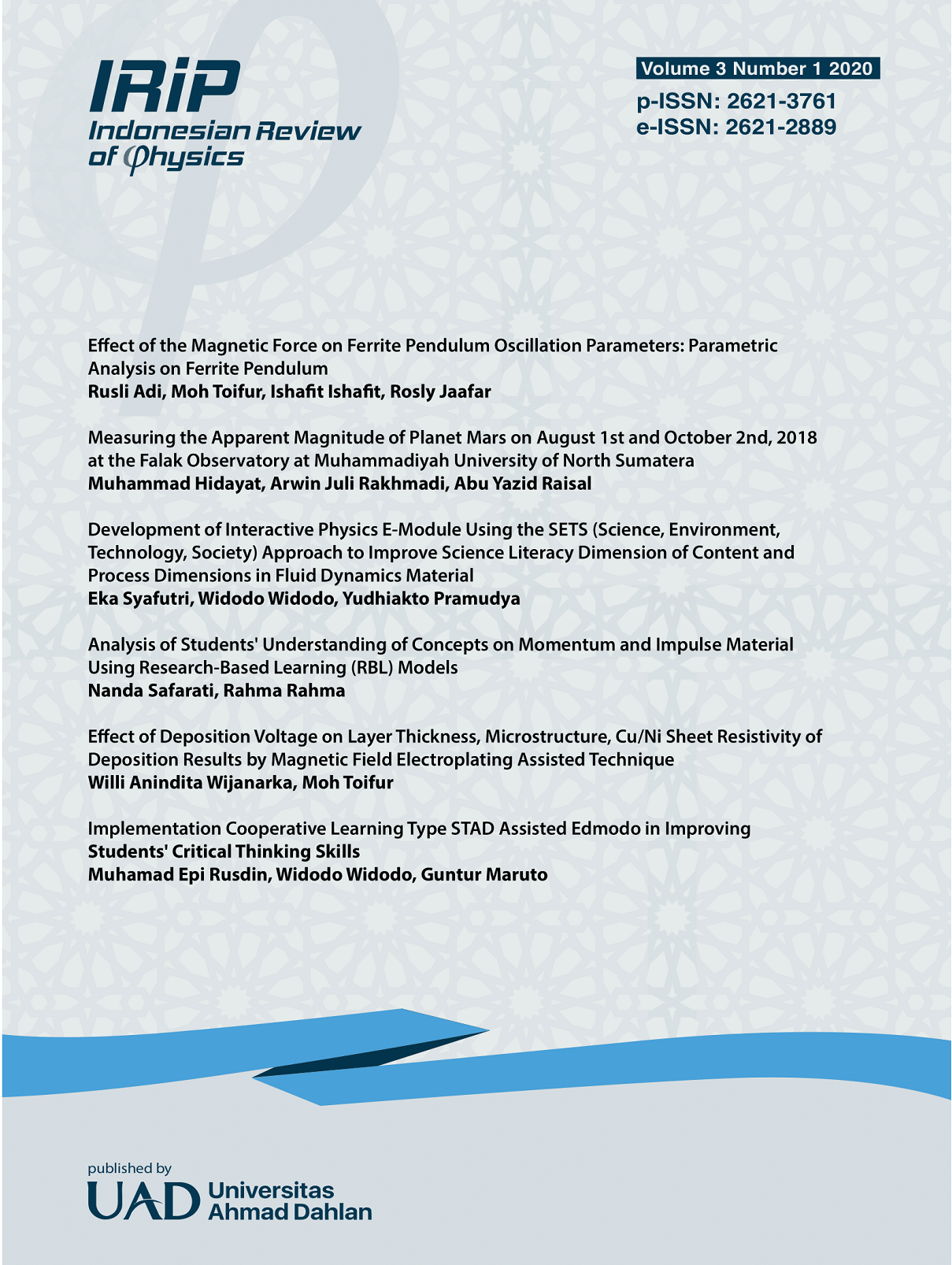Effect of the Magnetic Force on Ferrite Pendulum Oscillation Parameters: Parametric Analysis on Ferrite Pendulum
DOI:
https://doi.org/10.12928/irip.v3i1.1836Keywords:
Damping coefficient, Ferrite pendulum, Magnetic force, Swing pendulumAbstract
The magnitude of the damping force of the mathematical pendulum swinging on a medium is usually proportional to the speed of the pendulum. In this research, the pendulum oscillation parameters oscillating on an air medium under the influence of a magnetic field of 1.8 G will be investigated. In the initial stage, the effect of the magnetic force on the damping coefficient of ferrite pendulum oscillations with an initial deviation of 15 degrees observed. Furthermore, the study continued with varying the angle of deviation from 5 degrees to 25 degrees. The results of the data fitting amplitude (xi) at various swing times (ti) are using to analyze the effect of the angle of deviation on the maximum amplitude. The results showed that for the deviation angle of 15o the coefficient of damping of the medium affected by the magnetic force was 0,0022 greater than the coefficient of air damping 0,00006. It affects the amplitude, which decreases faster than the pendulum amplitude without the influence of magnetic force. Variation in the angle of deviation also affects the amplitude of the pendulum. In the deviation angle below 10, the pendulum motion is more influenced by the magnetic force, whereas in the deviation above 10, the pendulum motion is more dominated by gravity.References
[2] J. Sanada, K. Furuno, H. Hirakawa, and T. Kato, “Application of the Magnetic Fluid as A Detector for Changing the Magnetic Field Application of the Magnetic Fluid as A Detector for Changing the Magnetic Field,†Int. Conf. "Cognitive Robot., vol. 363, no. 012023, pp. 6–12, 2018.
[3] B. M. Teo, D. J. Young, and X. J. Loh, “Magnetic Anisotropic Particles : Toward Remotely Actuated Applications,†Part. Part. Syst. Charact., pp. 1–6, 2016.
[4] K. A. Kumar, S. F. Ali, and A. Arockiarajan, “Magneto-elastic Oscillator: Modeling and Analysis with Nonlinear Magnetic Interaction,†J. Sound Vib., vol. 393, pp. 265–284, 2017.
[5] A. I. Shumaev and Z. A. Maizelis, “Distribution Functions of Argumental Oscillations of the Duboshinskiy Pendulum,†Phys. Chem. Process., vol. 154902, no. 121, pp. 1–10, 2017.
[6] Y. Uzun, E. Kurt, and H. H. Kurt, “Explorations of Displacement and Velocity Nonlinearities and Their Effects to Power of a Magnetically-Excited Piezoelectric Pendulum Sensors and Actuators A : Physical Explorations of displacement and velocity nonlinearities and their effects to power of,†Sensors Actuators A. Phys., vol. 224, pp. 119–130, 2018.
[7] K. Polczyński, A. Wijata, and J. Awrejcewicz, “Theoretical and Numerical Analysis of Different Modes in a System of a ‘Kicked’ Magnetic Pendulum,†Theor. Approaches Non-Linear Dyn. Syst., pp. 431–440, 2019.
[8] R. A. Serway and J. W. J. Jewett, Physics for Scientists and Engineers with Modern Phy. United States: Thomson, 2008.
[9] E. I. Butikov, “Spring Pendulum with Dry and Viscous Damping,†Commun. Nonlinear Sci. Numer. Simul., vol. 20, no. 1, pp. 298–315, 2015.
[10] G. D. Quiroga and Ospina-Henao, “Dynamics of Damped Oscillations: Physical Pendulum,†EJP, pp. 1–5, 2017.
[11] G. L. Baker and J. A. Blackburn, “The Pendulum: a Case Study in Physics,†in The Pendulum: A Case Study in Physics, vol. 43, no. 06, New York: Oxford University Press, 2006, pp. 43-3440-43–3440.
[12] D. C. Giancoli, Physics for Scientists and Engineers with Modern Physics, vol. 26, no. 4. New Jersey: Pearson Prentice Hall, 1988.
[13] Y. Luo, W. Fan, C. Feng, S. Wang, and Y. Wang, “Subharmonic Frequency Response in a Magnetic Pendulum,†Am. J. Phys., vol. 88, no. 2, pp. 115–123, 2020.
[14] K. W. Yung, P. B. Landecker, and D. D. Villani, “An Analytic Solution for the Force Between Two Magnetic Dipoles,†Magn. Electr. Sep., vol. 9, no. 1, pp. 39–52, 1998.
[15] B. F. Edwards, D. M. Riffe, J.-Y. Ji, and W. A. Booth, “Interactions Between Uniformly Magnetized Spheres,†Am. J. Phys., vol. 85, no. 2, pp. 130–134, 2017.
[16] A. A. Khajetoorians et al., “Tailoring the Chiral Magnetic Interaction Between Two Individual Atoms,†Nat. Commun., vol. 7, pp. 1–8, 2016.
[17] L. P. Pook, Understanding Pendulum. Springer, 2011.
Downloads
Published
Issue
Section
License
Authors who publish in IRiP agree to the following terms: Authors retain copyright and grant the IRiP right of first publication with the work simultaneously licensed under a Creative Commons Attribution License (CC BY-SA 4.0) that allows others to share (copy and redistribute the material in any medium or format) and adapt (remix, transform, and build upon the material) the work for any purpose, even commercially with an acknowledgment of the work's authorship and initial publication in IRiP. Authors are able to enter into separate, additional contractual arrangements for the non-exclusive distribution of the journal's published version of the work (e.g., post it to an institutional repository or publish it in a book), with an acknowledgment of its initial publication in IRiP. Authors are permitted and encouraged to post their work online (e.g., in institutional repositories or on their website) prior to and during the submission process, as it can lead to productive exchanges, as well as earlier and greater citation of published work (See The Effect of Open Access).















